Sensor Sweep: Lovecraft, Morgoth vs. Sauron, Jonny Quest
Monday , 25, August 2025 Sensor Sweep Leave a commentForthcoming (Indigogo): Battleborn is a printed fantasy magazine dedicated to presenting all-new sword & sorcery fiction by the finest modern masters and rising stars in the subgenre, as well as reprinting the very best of genre classics and hidden gems for a new generation of readers?
D&D (Dungeons and Dragons Fan): Whether you’re a veteran Dungeon Master looking for a quick side quest or a new group hoping to try out Dungeons & Dragons for the first time, one-shots are a great way to experience the game. As the name suggests, these self-contained adventures are designed to be wrapped up in a single session, making them ideal for both beginners and experienced players.
Weird Tales (Tellers of Weird Tales): Macready contributed just one story to Weird Tales. Entitled “The Plant Thing,” it was published in July 1925 when its author was just twenty years old. “The Plant Thing” is a brief tale of a large, carnivorous plant, bred by a scientist who lives in a walled estate with his daughter and a Malay servant.
Tolkien (Realms Unravelled): Sauron and Morgoth – More Different than You Think
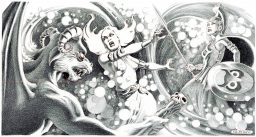 Art (Black Gate): When DAW Books launched in early 1972, one of their hallmarks was great cover art. Right from the start, their books featured covers by many of the top SF artists such as Frank Kelly Freas, John Schoenherr, Josh Kirby and Jack Gaughan – and eventually, Michael Whelan, who broke into the field with his cover for DAW’s edition of The Enchantress of World’s End by Lin Carter in 1975.
Art (Black Gate): When DAW Books launched in early 1972, one of their hallmarks was great cover art. Right from the start, their books featured covers by many of the top SF artists such as Frank Kelly Freas, John Schoenherr, Josh Kirby and Jack Gaughan – and eventually, Michael Whelan, who broke into the field with his cover for DAW’s edition of The Enchantress of World’s End by Lin Carter in 1975.
Science (Isegoria): Percival Lowell (1855 – 1916), the founder of the Lowell Observatory, inspired Martian romances like A Princess of Mars in multiple ways: Lowell, the liberally bankrolled son of a New England manufacturing dynasty, led an eccentric but not unproductive life, devoting himself in his twenties and thirties to the study of Far-Eastern religious practices and in the last half of his life to the study of the planet Mars.
H. P. Lovecraft (The Silver Key): And so was born “The Silver Key,” after the Lovecraft story set in his Dreamlands cycle. A somewhat obscure entry, but one of which I’m inordinately fond. The quote I’ve borne on the masthead remains as true today as the day he wrote it:
Fiction (The Second Story): What’s happening with “women’s literature”? How has romantasy taken over the publishing industry? How did we get here? And what does it mean?
Cinema (Zero Hedge): It sounds like they still hate the Gen Z male demographic while pretending as if those men are mysterious, stunted and hard to please. At no point does Disney question their previous DEI production policies. The obvious conclusion is that woke politics and the targeting of masculinity drove the male demographic away. Almost every Disney film with overt woke messaging has lost significant earnings in the past five years.
Small Press (REH.World): From April 2004 until December 2008 a scholarly bi-monthly journal called ‘The Cimmerian’ was published in print. The journal is dedicated to the life and writings of Robert E. Howard. It was edited by Leo Grin and consisted of 35 issues split into 5 volumes. It was also nominated for the World Fantasy Award twice.
Reviews (Bell Tube): 10 Fantasy Books I Regret Reading
Tolkien (SE Lindberg): Tolkien was known to visit the area while he studied at, and later became a professor at, Oxford University (Merton College). Much as we’d love to believe that the door was instrumental in the creation of the Doors or Durin, the claims have never been authenticated.
Cinema (Critical Drinker): A recent Variety article revealed that Disney is now looking for ways to win back young men to their brand, which is interesting for a company that owns both Star Wars and Marvel. How did it come to this? Let’s find out how Disney destroyed their male audience.
Cartoons (Golden Glamour Files): Join us as we dive into the thrilling world of Jonny Quest, the iconic animated series that captivated audiences in the 1960s! In this video, we countdown the top 10 episodes that showcase the adventurous spirit, unforgettable characters, and groundbreaking animation that made Jonny Quest a beloved classic.
Fiction (Adams Notes): One of the reasons for my admittedly obsessive interest in the pulps (popular fiction magazines printed in the U.S. during the early 20th century, up to roughly World War II) is that they’re a rich archive of not only writers, but of readers as well. Almost every magazine had a “letters to the editor” section where readers wrote in to praise authors they loved, grouse about stories they hated, and generally offer their thoughts, suggestions, and musings about the magazine and the genres they were interested in.
Art (Art of Michael Whelan): I rank Roger Zelazny as one of the best F/SF writers of his generation. One of my prime regrets is that I never got to meet him. I was immediately intrigued when offered the chance to provide covers for a multi-volume collection of his works by NESFA Press, the publishing side of the New England Science Fiction Association.
writers of his generation. One of my prime regrets is that I never got to meet him. I was immediately intrigued when offered the chance to provide covers for a multi-volume collection of his works by NESFA Press, the publishing side of the New England Science Fiction Association.
 Fiction (Black Gate): One of the more unusual items in my Sword & Planet collection is Sojarr of Titan, written by Manly Wade Wellman (1903 – 1986) and published by Crestwood Publishing Company. This is a first edition, I believe, printed in 1949. The story originally appeared in the March 1941 issue of Startling Stories, published by Better Publishing, Inc.
Fiction (Black Gate): One of the more unusual items in my Sword & Planet collection is Sojarr of Titan, written by Manly Wade Wellman (1903 – 1986) and published by Crestwood Publishing Company. This is a first edition, I believe, printed in 1949. The story originally appeared in the March 1941 issue of Startling Stories, published by Better Publishing, Inc.
Gaming (Auron McIntyre): The Rise and Fall of Video Games | Guest: Marty O’Donnell
D&D (Dungeons and Dragons Fan): The past few years have seen a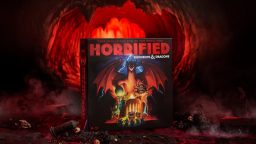 resurgence in D&D board games, with everything from head-to-head skirmish games like WizKids’ Onslaught to city building strategy titles like Builders of Baldur’s Gate and the upcoming mapping game Edge of the Realms. Most of these games have been well received by both Dungeons & Dragons fans and board game aficionados alike, paving the way for newer releases.
resurgence in D&D board games, with everything from head-to-head skirmish games like WizKids’ Onslaught to city building strategy titles like Builders of Baldur’s Gate and the upcoming mapping game Edge of the Realms. Most of these games have been well received by both Dungeons & Dragons fans and board game aficionados alike, paving the way for newer releases.
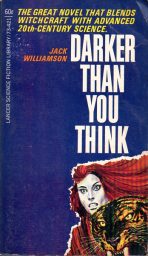 Fiction (Ken Lizzi): Darker Than You Think does live up to the title in a slow burn fashion. It follows the dawning realization of the protagonist — Will Barbee, hardbitten, alcoholic journalist — that dark forces, witchcraft, and horrific legends of the past are all based on a semi-human race of beings. And that he might in fact be one of them. This is, fundamentally, a horror novel. While some of the horror does come from witchcraft, lycanthropy, and monster attacks, most of it is psychological as Barbee fights against revelations of his own nature.
Fiction (Ken Lizzi): Darker Than You Think does live up to the title in a slow burn fashion. It follows the dawning realization of the protagonist — Will Barbee, hardbitten, alcoholic journalist — that dark forces, witchcraft, and horrific legends of the past are all based on a semi-human race of beings. And that he might in fact be one of them. This is, fundamentally, a horror novel. While some of the horror does come from witchcraft, lycanthropy, and monster attacks, most of it is psychological as Barbee fights against revelations of his own nature.
Fantasy (Express): George RR Martin, one of the most renowned authors for writing fantasy novels has shared the 10 books he recommends and a classic British fantasy has made it to the top of his list. Writing the recommendations for Goodreads, the popular author placed Lord of the Rings on the top position.
H. P. Lovecraft (DMR Books): H.P. Lovecraft would’ve turned one hundred and thirty-five as of yesterday. That birthday also marks a solid century of pop culture dominance. By this time in August of 1925, HPL had turned the heads of Clark Ashton Smith, Robert E. Howard and many, many others. ‘Others’ like C.L. Moore and Manly Wade Wellman. ‘Others’ like Robert Bloch and Ray Bradbury.
H. P. Lovecraft (Goodman Games): Gary Gygax named H. P. Lovecraft as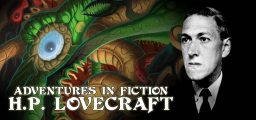 one of the immediate influences in the Dungeon Masters Guide’s Appendix N. Lovecraft is best known for the creation of the alien god, Cthulhu, from the short story “The Call of Cthulhu” published in Weird Tales in 1928 (and be sure to check out our collection of reprints featuring Lovecraft’s works).
one of the immediate influences in the Dungeon Masters Guide’s Appendix N. Lovecraft is best known for the creation of the alien god, Cthulhu, from the short story “The Call of Cthulhu” published in Weird Tales in 1928 (and be sure to check out our collection of reprints featuring Lovecraft’s works).
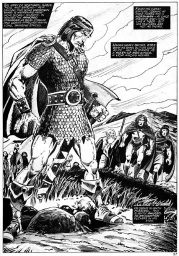 Comic Books (Dark Worlds Quarterly): The story was adapted by Roy Thomas for Savage Sword of Conan #68-69, September-October 1981. Typical back page stuff for Savage Sword but I will admit my fondness for such has grown while my love of the photocopied adventures of Conan have not. Gene Day was always great even when inked by someone else.
Comic Books (Dark Worlds Quarterly): The story was adapted by Roy Thomas for Savage Sword of Conan #68-69, September-October 1981. Typical back page stuff for Savage Sword but I will admit my fondness for such has grown while my love of the photocopied adventures of Conan have not. Gene Day was always great even when inked by someone else.
Horror (MSN): While H.P. Lovecraft was responsible for popularizing one of the most profoundly terrifying genres of horror imaginable, he was also a total bigot. A xenophobic shut in, many of Lovecraft’s stories were inspired by his fear foreign cultures, and his racism is often reflected in his fiction. Plenty of modern authors have made superior contributions to cosmic horror, without any of the problematic views. Here they are, the 10 best cosmic horror sci-fi books with which Lovecraft was entirely uninvolved.
H. P. Lovecraft (Grognardia): 1929 saw the publication of H.P. Lovecraft’s “The Silver Key,” a wistful, semi-autobiographical tale of Randolph Carter, his recurring dreamer-protagonist. In that story, Carter, now middle-aged, finds himself disillusioned with the mundane world, bereft of the golden moments of his youth when he roamed the Dreamlands freely. After discovering an old silver key in his ancestral home, Carter then departs for the wooded hills of his boyhood and disappears.
History (Frontier Partisans): I am fascinated by holdouts — men who refuse to acknowledge that they are beaten, warriors who head deep into the hinterlands to carry on their struggle. Some of my favorite work here was my series on Apache holdouts after Geronimo’s 1886 surrender.
Please give us your valuable comment